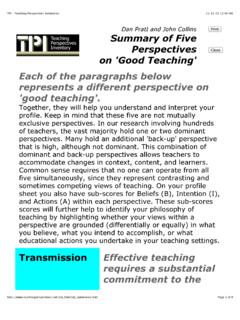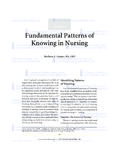Transcription of THE PRINCIPAL ELEMENTS OF THE NATURE OF SCIENCE ...
1 THE PRINCIPAL ELEMENTS OF THE NATURE OF SCIENCE : DISPELLING. THE MYTHS. William F. McComas Rossier School of Education - WPH. Univerisity of Southern California Los Angeles, CA 90089-0031. Adapted from the chapter in W. F. McComas (ed.) The NATURE of SCIENCE in SCIENCE Education, 53-70. 1998 Kluwer Academic Publishers. Printed in the Netherlands. The myths of SCIENCE discussed here are commonly included in SCIENCE textbooks, in classroom discourse and in the minds of adult Americans. These fifteen issues, described here as myths of SCIENCE , do not represent all of the important issues that teachers should consider when designing instruction relative to the NATURE of SCIENCE , but may serve as starting points for evaluating current instructional foci while enhancing future curriculum design.
2 Misconceptions about SCIENCE are most likely due to the lack of philosophy of SCIENCE content in teacher education programs and the failure of such programs to provide real SCIENCE research experiences for preservice teachers while another source of the problem may be the generally shallow treatment of the NATURE of SCIENCE in the textbooks to which teachers might turn for guidance. Some of these myths, such as the idea that there is a scientific method, are most likely caused by the explicit inclusion of faulty ideas in textbooks while others, such as lack of knowledge of the social construction of scientific knowledge, are the result of omissions in texts.
3 As Steven Jay Gould points out in The Case of the Creeping Fox Terrier Clone (1988), SCIENCE textbook writers are among the most egregious purveyors of myth and inaccuracy. The fox terrier refers to the classic comparison used to express the size of the dawn horse, tiny precursor to the modern horse. This comparison is unfortunate for two reasons. Not only was this horse ancestor much bigger than a fox terrier, but the fox terrier breed of dog is virtually unknown to American students. The major criticism leveled by Gould is that once this comparison took hold, no one bothered checking its validity or utility.
4 Through time, one author after another simply repeated the inept comparison and continued a tradition making many SCIENCE texts virtual clones of each other on this and countless other points. In an attempt to provide a more realistic view of SCIENCE and point out issues on which SCIENCE teachers should focus, this chapter presents and discusses fifteen widely held, yet incorrect ideas about the NATURE of SCIENCE . There is no implication that all students, or most teachers for that matter , hold all of these views to be true, nor is the list meant to be the definitive catalog.
5 Cole (1986) and Rothman (1992). ave suggested additional misconceptions worthy of consideration. However, years of 2. SCIENCE teaching and the review of countless texts has substantiated the validity of the following inventory presented here. MYTH 1: HYPOTHESES BECOME THEORIES THAT IN TURN BECOME LAWS. This myth deals with the general belief that with increased evidence there is a developmental sequence through which scientific ideas pass on their way to final acceptance (see Figure 1) as mature laws. The implication is that hypotheses and theories are less secure than laws.
6 A former president expressed his misunderstanding of SCIENCE by saying that he was not troubled by the idea of evolution because it was, in his words, just a theory. The president's misstatement is the essence of this myth; an idea is not worthy of consideration until lawness has been bestowed upon it. Law Theory Hypothesis Facts and Observations Figure 1. The false hierarchical relationship between facts, hypotheses, theories and laws. Theories and laws are very different kinds of knowledge, but the misconception portrays them as different forms of the same knowledge construct.
7 Of course there is a relationship between laws and theories, but it is not the case that one simply becomes the other -- no matter how much empirical evidence is amassed. Laws are generalizations, principles or patterns in NATURE and theories are the explanations of those generalizations (Rhodes and Schaible, 1989; Horner and Rubba, 1979; Campbell, 1953). Dunbar (1995) addresses the distinction in a very useful fashion by calling laws cookbook SCIENCE , and the explanations theoretical SCIENCE . He labels the multiple examples of the kind of SCIENCE practiced by traditional peoples as cookbook because those who apply the rules after observing the patterns in NATURE do not understand why NATURE operates in the fashion that it does.
8 The rules work and that is enough. Even in more sophisticated settings, cookbook SCIENCE is occasionally practiced. For example, Newton described the relationship of mass and distance to gravitational attraction between objects with such precision that we can use the law of gravity to plan space flights. During the Apollo 8 mission, astronaut Bill Anders 3. responded to the question of who was flying the spacecraft by saying, I think Isaac Newton is doing most of the driving right now (Chaikin, 1994, p. 127). His response was understood to mean that the capsule was simply following the basic laws of physics described by Isaac Newton centuries earlier.
9 The more thorny, and many would say more interesting, issue with respect to gravity is the explanation for why the law operates as it does. At this point, there is no well-accepted theory of gravity. Some physicists suggest that gravity waves are the correct explanation, but with clear confirmation and consensus lacking, most feel that the theory of gravity still eludes SCIENCE . Interestingly, Newton addressed the distinction between law and theory with respect to gravity. Although he had discovered the law of gravity, he refrained from speculating about its cause.
10 In Principia, Newton states .. I have not been able to discover the cause of those properties of gravity from phenomena, and I frame no hypothesis .. it is enough that gravity does really exist, and act according to the laws which we have explained .. (Newton, 1720/1946, p. 547). MYTH 2: SCIENTIFIC LAWS AND OTHER SUCH IDEAS ARE ABSOLUTE. This myth involves two ELEMENTS . First, even if individuals understand that scientific laws are equal in importance to theories, they rarely appreciate that all knowledge in SCIENCE is tentative, occasionally seeing proof in SCIENCE equal to proof in mathematics.




